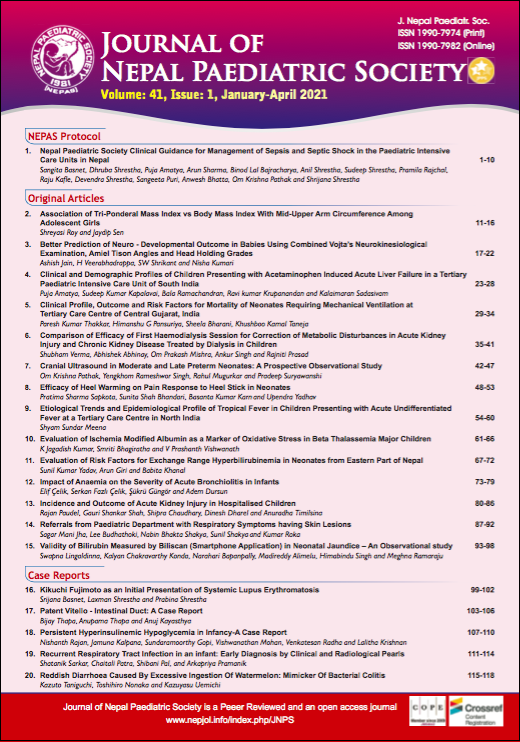Nepal Paediatric Society Clinical Guidance for Management of Sepsis and Septic Shock in the Paediatric Intensive Care Units in Nepal
DOI:
https://doi.org/10.3126/jnps.v41i1.35075Keywords:
Sepsis, septic shock, pediatrics, Nepal, Guidelines, management, Critical careAbstract
Justification: Sepsis is a major cause of morbidity and mortality in Nepal. There is a lack of standardisation in the management of severe sepsis and septic shock. Additionally, international guidelines may not be completely applicable to resource limited countries like Nepal.
Objective: Create a collaborative standardised protocol for management of severe sepsis and septic shock for Nepal based on evidence and local resources.
Process / Methods: Paediatricians representing various paediatric intensive care units all over Nepal gathered to discuss clinical practice and delivery of care of sepsis and septic shock under the aegis of Nepal Paediatric Society. After three meetings and several iterations a standardised protocol and algorithm was developed by modifying the existing Surviving Sepsis Guidelines to suit local experience and resources.
Recommendations: Paediatric sepsis and septic shock definitions and management in the early hours of presentation are outlined in text and flow diagram format to simplify and standardise delivery of care to children in the paediatric intensive care setting. These are guidelines and may need to be modified as necessary depending on the resources availability and lack thereof. It is recommended to analyse data moving forward and revise every few years in the advent of additional data.
Downloads
Downloads
Published
How to Cite
Issue
Section
License
Authors who publish with this journal agree to the following terms:
Authors retain copyright and grant the journal right of first publication with the work simultaneously licensed under a Creative Commons Attribution License that allows others to share the work with an acknowledgement of the work's authorship and initial publication in this journal.
Authors are able to enter into separate, additional contractual arrangements for the non-exclusive distribution of the journal's published version of the work (e.g., post it to an institutional repository or publish it in a book), with an acknowledgement of its initial publication in this journal.
Authors are permitted and encouraged to post their work online (e.g., in institutional repositories or on their website) prior to and during the submission process, as it can lead to productive exchanges, as well as earlier and greater citation of published work (See The Effect of Open Access).



